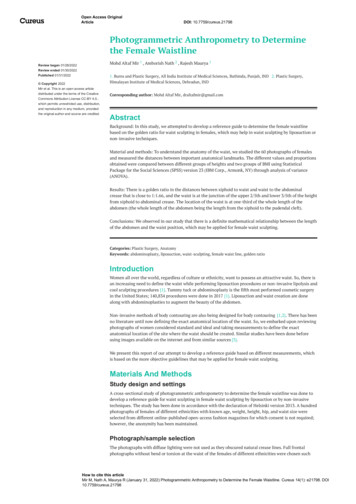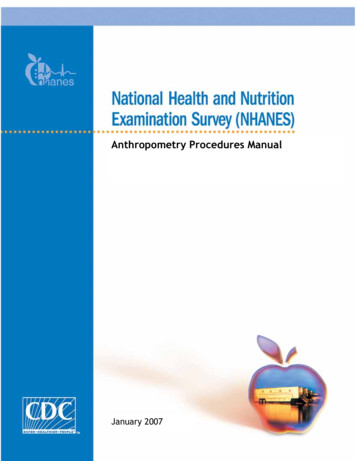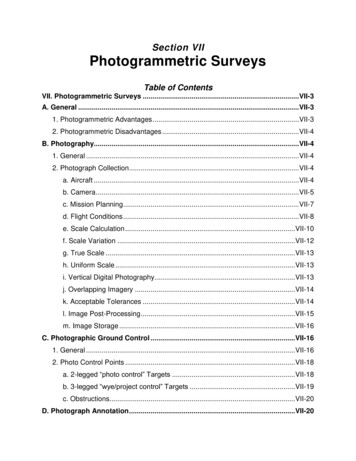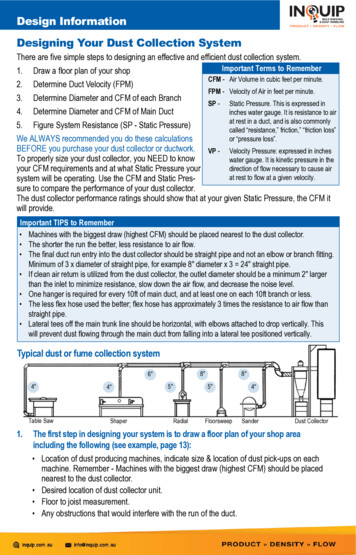
Transcription
Open Access OriginalArticleDOI: 10.7759/cureus.21798Photogrammetric Anthropometry to Determinethe Female WaistlineMohd Altaf Mir 1 , Amborish Nath 2 , Rajesh Maurya 1Review began 01/28/2022Review ended 01/30/20221. Burns and Plastic Surgery, All India Institute of Medical Sciences, Bathinda, Punjab, IND 2. Plastic Surgery,Himalayan Institute of Medical Sciences, Dehradun, INDPublished 01/31/2022 Copyright 2022Mir et al. This is an open access articledistributed under the terms of the CreativeCommons Attribution License CC-BY 4.0.,Corresponding author: Mohd Altaf Mir, draltafmir@gmail.comwhich permits unrestricted use, distribution,and reproduction in any medium, providedthe original author and source are credited.AbstractBackground: In this study, we attempted to develop a reference guide to determine the female waistlinebased on the golden ratio for waist sculpting in females, which may help in waist sculpting by liposuction ornon-invasive techniques.Material and methods: To understand the anatomy of the waist, we studied the 60 photographs of femalesand measured the distances between important anatomical landmarks. The different values and proportionsobtained were compared between different groups of heights and two groups of BMI using StatisticalPackage for the Social Sciences (SPSS) version 23 (IBM Corp., Armonk, NY) through analysis of variance(ANOVA).Results: There is a golden ratio in the distances between xiphoid to waist and waist to the abdominalcrease that is close to 1:1.66, and the waist is at the junction of the upper 2/5th and lower 3/5th of the heightfrom xiphoid to abdominal crease. The location of the waist is at one-third of the whole length of theabdomen (the whole length of the abdomen being the length from the xiphoid to the pudendal cleft).Conclusions: We observed in our study that there is a definite mathematical relationship between the lengthof the abdomen and the waist position, which may be applied for female waist sculpting.Categories: Plastic Surgery, AnatomyKeywords: abdominoplasty, liposuction, waist-sculpting, female waist line, golden ratioIntroductionWomen all over the world, regardless of culture or ethnicity, want to possess an attractive waist. So, there isan increasing need to define the waist while performing liposuction procedures or non-invasive lipolysis andcool sculpting procedures [1]. Tummy tuck or abdominoplasty is the fifth most performed cosmetic surgeryin the United States; 140,834 procedures were done in 2017 [1]. Liposuction and waist creation are donealong with abdominoplasties to augment the beauty of the abdomen.Non-invasive methods of body contouring are also being designed for body contouring [1,2]. There has beenno literature until now defining the exact anatomical location of the waist. So, we embarked upon reviewingphotographs of women considered standard and ideal and taking measurements to define the exactanatomical location of the site where the waist should be created. Similar studies have been done beforeusing images available on the internet and from similar sources [3].We present this report of our attempt to develop a reference guide based on different measurements, whichis based on the more objective guidelines that may be applied for female waist sculpting.Materials And MethodsStudy design and settingsA cross-sectional study of photogrammetric anthropometry to determine the female waistline was done todevelop a reference guide for waist sculpting in female waist sculpting by liposuction or by non-invasivetechniques. The study has been done in accordance with the declaration of Helsinki version 2013. A hundredphotographs of females of different ethnicities with known age, weight, height, hip, and waist size wereselected from different online-published open-access fashion magazines for which consent is not required;however, the anonymity has been maintained.Photograph/sample selectionThe photographs with diffuse lighting were not used as they obscured natural crease lines. Full frontalphotographs without bend or torsion at the waist of the females of different ethnicities were chosen suchHow to cite this articleMir M, Nath A, Maurya R (January 31, 2022) Photogrammetric Anthropometry to Determine the Female Waistline. Cureus 14(1): e21798. DOI10.7759/cureus.21798
that it had the abdominal crease line and the vulvar cleft exposed. Hundred out of 300 photographs offemales of different ethnicities were selected and rated a score of 7 and more on a scale of 0 to 10 accordingto the choice of 10 females and 10 males not related to the medical profession. An expert panel wasappointed to judge and select the photographs and to consider whether the photographs were aestheticallyoptimal (7 or more) on a scale of 0-10. The panel consisted of three independent plastic surgeons who ratedthe photographs from the above-selected pool of 100 photographs. The 70 photographs with the highestratings (score of 7 and more) were selected. However, we had to decrease the number down to 60 afterexclusion of the photographs with overtly bent back, with some minor twisting of the waist, and where theabdominal crease was not properly visible.Photogrammetric anthropometryPhotogrammetric anthropometry was performed as shown in Figure 1 (Panels A and B) (authors' owncreation). The distance from the upper end of the pudendal cleft to the umbilicus is “p.” The umbilicus issaid to be lying in the midpoint between the upper end of the pudendal cleft and the xiphoid [4-7].Measuring the distance of the pudendal cleft from the umbilicus provided us with the approximate locationof the xiphoid process. The distance from the approximate area of the xiphoid process and the umbilicus “a”is equal to the distance from the upper end of the pudendal cleft to the umbilicus “p” (p a). A naturalcrease line exists just above the mons pubis indicating the area where the recti muscles attach to the pubicbones. The distance from the umbilicus to the abdominal crease line “b” is marked. The abdominal creaseline is prominent in most females; however, in skinny or athletic females, the crease is faintlyconspicuous. A point “1” was selected on this crease line, where it intersects the line drawn between theumbilicus and the pudendal cleft. The waist is defined as the narrowest point of the torso below the ribs andabove the hips. On the frontal images of the models, the waist points were marked on both the sides of thetorso and joined by a line called waist point line “y,” and the point where this line intersects the line betweenthe xiphoid and the umbilicus is chosen as the point “2.” The distance from the waist point line to theabdominal crease line, i.e., the distance between 1 and 2 is “x.” The following ratios a/b, a/x, b/y, and x/ywere calculated.FIGURE 1: Indirect anthropometry on photographFigure 1A shows indirect anthropometry on the photograph of a female model, while Figure 1B shows indirectanthropometry on the pencil sketch of an ideal female model created by authors. Both panels show a vertical linefrom the xiphoid to upper end of the pudendal cleft. A lower transverse line passes through the lowest most point ofthe naturally existing abdominal crease line just above the mons pubis. This line intersects the vertical line at point1. Another horizontal line is drawn at the narrowest point of the torso below the ribs and above the hips (waist).This line intersects with the vertical line at point 2. It also shows a, b, x, and y distances as described in the article.Data collection and statistical analysisThe data collected were tabulated in a Microsoft Excel spreadsheet (Microsoft Corporation, New Mexico,2022 Mir et al. Cureus 14(1): e21798. DOI 10.7759/cureus.217982 of 9
USA) followed by statistical analysis. The different values and proportions obtained were compared betweendifferent groups of heights and two groups of BMI using Statistical Package for the Social Sciences (SPSS)version 23 (IBM Corp., Armonk, NY) through analysis of variance (ANOVA).ResultsThe mean age, weight, height, BMI, and waist to hip ratio calculated on photogrammetric anthropometry are22.65 2.84 years, 50.41 4.85 kg, 167.38 6.19 cm, 18.00 1.56, and 0.71 0.043, respectively. Thecalculation of different ratios as depicted in Figure 1 from the above measurements is depicted in Table 1and the remaining figures in this article.ParametersHeight 170 (cm)Height 170 (cm)BMI 18.5 (kg/m2 )BMI 18.5 (kg/m2 )StatisticsPencil art of models29312832-Mean age (years)22.05 2.8421.89 2.7323.67 2.2723.80 2.50p 0.05 (IS)Mean weight (kg)51.41 4.8549.81 4.0550.41 4.8548.81 4.95p 0.05 (IS)Mean height (cm)170.01 6.19169.88 6.09170.08 6.29169.98 6.09p 0.05 (IS)Mean BMI (kg/m2 )18.95 1.5618.09 1.2618.75 1.6618.09 1.25p 0.05 (IS)Mean hip to waist ratio0.70 0.090.71 0.040.70 0.080.71 0.05p 0.05 (IS)Mean a/b ratio1.55 0.151.54 0.161.55 0.171.54 0.14p 0.05 (IS)Mean a/x ratio1.01 0.061.02 0.051.02 0.061.03 0.07p 0.05 (IS)Mean b/y ratio1.16 0.251.15 0.261.14 0.261.14 0.27P 0.05 (IS)Mean x/y ratio1.39 0.291.41 0.991.45 0.191.46 0.29p 0.05 (IS)TABLE 1: Summary of different parameters and ratios calculated on photogrammetricanthropometry of 60 females to determine the ideal female waistlinea, b, x, and y are described in Figure 1.IS, Insignificant.The mean a/b ratio calculated is 1.54 0.14. Comparing the a/b values in different groups of heights, the Pvalue was found to be 0.997, which is an insignificant difference in value among the subgroups (Figure 2).2022 Mir et al. Cureus 14(1): e21798. DOI 10.7759/cureus.217983 of 9
FIGURE 2: Box plot comparison of a/b values based on heightIt shows the comparison of the a/b values in different groups of heights and shows that there is an insignificantdifference in value among the subgroups.Comparing the a/b values in the two groups of BMI, the P-value was found to be 0.145, which is aninsignificant difference in value among the subgroups (Figure 3).FIGURE 3: Box plot comparison of a/b values based on BMIIt shows the comparison of the a/b values in different groups of BMI and shows that there is an insignificantdifference in value among the subgroups.The mean a/x ratio calculated is 1.02 0.06. Comparing the a/x values in different groups of heights, the Pvalue was found to be 0.997, which is an insignificant difference in value among the subgroups (Figure 4).2022 Mir et al. Cureus 14(1): e21798. DOI 10.7759/cureus.217984 of 9
FIGURE 4: Box plot comparison of a/x values based on heightIt shows the comparison of the a/x values in different groups of heights and shows that there is an insignificantdifference in value among the subgroups.Comparing the a/x values in the two groups of BMI, the P-value was found to be 0.145, which is aninsignificant difference in value among the subgroups (Figure 5).FIGURE 5: Box plot comparison of a/x values based on BMIIt shows the comparison of the a/x values in different groups of BMI and shows that there is an insignificantdifference in value among the subgroups.The mean b/y ratio calculated is 1.14 0.26. Comparing the b/y values in different groups of heights, the Pvalue was found to be 0.967, which is an insignificant difference in value among the subgroups (Figure 6).2022 Mir et al. Cureus 14(1): e21798. DOI 10.7759/cureus.217985 of 9
FIGURE 6: Box plot comparison of b/y values based on heightIt shows the comparison of the b/y values in different groups of heights and shows that there is an insignificantdifference in value among the subgroups.Comparing the b/y values in the two groups of BMI, the P-value was found to be 0.839, which is aninsignificant difference in value among the subgroups (Figure 7).FIGURE 7: Box plot comparison of b/y values based on BMIIt shows the comparison of the b/y values in different groups of BMI and shows that there is an insignificantdifference in value among the subgroups.The mean x/y ratio calculated is 1.45 0.19. Comparing the x/y values in different groups of heights, the Pvalue was found to be 0.730, which is an insignificant difference in value among the subgroups (Figure 8).2022 Mir et al. Cureus 14(1): e21798. DOI 10.7759/cureus.217986 of 9
FIGURE 8: Box plot comparison of x/y values based on heightIt shows the comparison of the x/y values in different groups of heights and shows that there is an insignificantdifference in value among the subgroups.Comparing the x/y values in the two groups of BMI, the P-value was found to be 0.305, which is aninsignificant difference in value among the subgroups (Figure 9).FIGURE 9: Box plot comparison of x/y values based on BMIIt shows the comparison of the x/y values in different groups of BMI and shows that there is an insignificantdifference in value among the subgroups.The above calculations show no significant differences among the various subgroups. So, we can assume thata 1.5 b (since a/b is approximately 1.5) and (a b)/a 1.66. This shows that the distance “a” is roughlyequal to the distance “x,” since a/x is roughly equal to 1. And b/y is roughly equal to 1, so the distance “y” isroughly equal to the distance “b.” Distance “a” bears a relationship with distance “b,” and “x” with “y,” andthe two ratios of a/b are equal to x/y. There is a relationship between the distance “a” and the length of theabdomen “(a b),” which is 1.66, equal to a near golden ratio. Similarly, the distance “x” bears a similarrelation with the length of the abdomen “(x y).”Discussion2022 Mir et al. Cureus 14(1): e21798. DOI 10.7759/cureus.217987 of 9
A well-done tummy tuck when combined with liposuction can produce remarkable results. At times, theprofile of the abdomen after abdominoplasty is flat on the sides, and it requires to be coupled withliposuction or other non-invasive procedure to create a waist [2]. There has been no objective anatomicalguide to the location of the waist. Previously, the terms such as “just below the ribs” and “just above thenavel” were used. There is no convincing textual lead available as yet.We have used photographs of females, and similar techniques have been used before to studyanthropometry [3]. It is easy and convenient to access photographs through the internet. We referred to astudy by Lee et al. where the investigator studied the photographs of models and used software to alter thelight exposure to define the xiphoid process [3]. It is difficult to clearly define the xiphoid process by thatmethod; however, we can get an approximate idea about the location of the xiphoid process.In our study, we manipulated the images by changing the light exposure using software to identify theabdominal crease. The pudendal or the labial cleft could be used as a reference landmark because thephotographs selected had to have exposed labial cleft as a selection criterion. We have calculated theapproximate supposed distance of the xiphoid from the navel using the knowledge from the previous studiesabout the abdominoplasties [4-7]. These studies mention the distance between the xiphoid to umbilicus andumbilicus to the pudendal cleft is the same. We have taken this guide in our study. There is a mention of therelation between the umbilicus and the position of the waist. The umbilicus is said to lie 1-4 cm below thewaistline [4-7]. However, there is no defined landmark for the waist, with respect to the length of theabdomen. The distance of the navel from the waistline may vary among patients of different heights.The subjects of the photographs used in the study were of age 22.65 2.64 years, height of 167.38 6.19 cm,and BMI of 18.0024 1.566. There was no significant variation among the various parameters measured onthe basis of height or BMI. The measurements were on females photographed in standing positions only. So,the effect of change of the measurements on lying down could not be commented upon. The abdominoplastysurgeries are done with the patient in a supine position, so the waist position of the patient in the supineposition might be different from the position on standing. However, the marking for the procedure is alwaysdone in a standing position prior to the surgery for which our results would be helpful to predict the femalewaistline.We found in our study that the waist bears a mathematical relation with the xiphoid process and theabdominal crease. The ratio y:x ( 1:1.5) suggests that the waist is at the junction of the upper 2/5th andlower 3/5th of the height from the xiphoid to the abdominal crease. Hence, the vertical distance between thexiphoid and the abdominal crease and the distance from the waist to the abdominal crease line bears a ratioof 1.66:1.Abdominoplasty involves the transverse incision near the abdominal crease region; the scar is placed just 1-2cm below the abdominal crease, roughly taken as 6-7 cm above the pudendal cleft as described in thetextbook of Plastic Surgery by Peter C Neligan [8]. The abdominal crease region is chosen because it is alsonormally the region where the upper hemline of underwear rests and the scar can be hidden under theunderwear or the swimwear. The scar aligns well with crease lines, hence is cosmetically favorable.The relation of the umbilicus with the abdominal crease has never been studied before, and we also foundthat the umbilicus also has a mathematical relationship with the xiphoid and the abdominal crease. Thedistance from the xiphoid to the umbilicus is 1.5 times the distance from the umbilicus to the abdominalcrease, and the vertical distance between the xiphoid and the abdominal crease and the distance between thexiphoid and the umbilicus have a ratio of 1.66:1, which is reasonably close to the golden ratio. The aboveknowledge can act as a guide while creating the neo-umbilicus during abdominoplasty as well.Whole length of the abdomen from xiphoid to pudendal cleft “A” a b 2a 2 x 1.5b 3b. The b isapproximately equal to y. Hence A 3y and y A/3. So, we can say that the location of the waist in ourselected population is at one-third of the whole length of the abdomen from the xiphoid process (the wholelength of the abdomen being the length from the xiphoid to the pudendal cleft).Thus, these anthropometric calculations may guide us about the approximate position of the waist for bodycontouring in females. Until now, the guidelines to the location of waste have been 1-4 cm above the navelas per plastic surgery textbook guidelines or just below the ribs as per finest art books. Some fine art bookssuggest that the level of the elbow with the arms by the side in a standing position is the level of the waist[9]. Thus, we could deduce the waist position based on bony landmarks. Hence the discrepancies due toconsiderations of the soft tissue landmarks can be sorted out. There are only a few studies for the descriptionof waist localization [10-12], and hence, our study might add to the literature the indirect anthropometricevaluation of waist position in adult females.We observed in our study that there is a definite mathematical relationship between the length of theabdomen and the position of the waist, which may be applied for female waist sculpting. However, adrawback of our study is the number of images studied was 60; a greater sample size could have given usmore accuracy. Further studies of this kind may be needed for the augmentation of evidence, and studies2022 Mir et al. Cureus 14(1): e21798. DOI 10.7759/cureus.217988 of 9
with measurements directly on human subjects are also needed to validate the evidence. We are lookingforward to working on such a study in the future with better anthropometric tools and its surgical validation.ConclusionsWe observed in our study that there is a definite mathematical relationship between the length of theabdomen and the waist position, which may be applied for female waist sculpting.Additional InformationDisclosuresHuman subjects: All authors have confirmed that this study did not involve human participants or tissue.Animal subjects: All authors have confirmed that this study did not involve animal subjects or tissue.Conflicts of interest: In compliance with the ICMJE uniform disclosure form, all authors declare thefollowing: Payment/services info: All authors have declared that no financial support was received fromany organization for the submitted work. Financial relationships: All authors have declared that they haveno financial relationships at present or within the previous three years with any organizations that mighthave an interest in the submitted work. Other relationships: All authors have declared that there are noother relationships or activities that could appear to have influenced the submitted work.AcknowledgementsWe acknowledge the free-access online fashion magazines viz Global Garbs, Modeliste, Salyse, LondonRunway, and Fashion Advocate; we have used the female photographs published in these magazines .12.Harper M, Lassetter J: Cryolipolysis: a guide for primary care practitioners . J Nurse Pract. 2019, 15:666-70.10.1016/j.nurpra.2019.07.001Lee NY, Robinson DM: Noninvasive body contouring . Semin Cutan Med Surg. 2017, 36:170-8.10.12788/j.sder.2017.043Lee SJ, Garg S, Lee HP: Computer-aided analysis of the "beautiful" umbilicus . Aesthet Surg J. 2014, 34:74856. 10.1177/1090820X14533565Stoff A, Richter DF: Abdominoplasty and body contouring. Plastic and Reconstructive Surgery. FarhadiehRD, Bulstrode NW, Cugno S (ed): John Wiley & Sons, Hoboken, NJ; 2015. 21:1083-103.10.1002/9781118655412.ch76Richter DF, Stoff A: The scarpa lift--a novel technique for minimal invasive medial thigh lifts . Obes Surg.2011, 21:1975-80. 10.1007/s11695-011-0474-2Richter DF, Stoff A, Velasco-Laguardia FJ, Reichenberger MA: Circumferential lower truncaldermatolipectomy. Clin Plast Surg. 2008, 35:53-71. 10.1016/j.cps.2007.09.001Richter DF, Stoff A: Circumferential body contouring: the lower body lift . Clin Plast Surg. 2014, 41:775-88.10.1016/j.cps.2014.07.004Saldanha OR, Federico R, Daher PF, et al.: Lipoabdominoplasty. Plast Reconstr Surg. 2009, 124:934-42.10.1097/PRS.0b013e3181b037e3Wu F: The Poetics of Decadence: Chinese Poetry of the Southern Dynasties and Late Tang Periods . StateUniversity of New York Press, Albany, NY; 1998.Guerra RS, Amaral TF, Marques EA, Mota J, Restivo MT: Anatomical location for waist circumferencemeasurement in older adults: a preliminary study. Nutr Hosp. 2012, 27:1554-61. 10.3305/nh.2012.27.5.5922Veitch D: Where is the human waist? Definitions, manual compared to scanner measurements . Work. 2012,41:4018-24. 10.3233/WOR-2012-0065-4018Teimourian B, Adham MN, Malekzadeh S: Waistline cincture. Aesthet Surg J. 1998, 18:458-60.10.1016/s1090-820x(98)70080-92022 Mir et al. Cureus 14(1): e21798. DOI 10.7759/cureus.217989 of 9
Keywords: abdominoplasty, liposuction, waist-sculpting, female waist line, golden ratio Introduction Women all over the world, regardless of culture or ethnicity, want to possess an attractive waist. So, there is an increasing need to define the waist while performing liposuction procedures or non-invasive lipolysis and cool sculpting .










